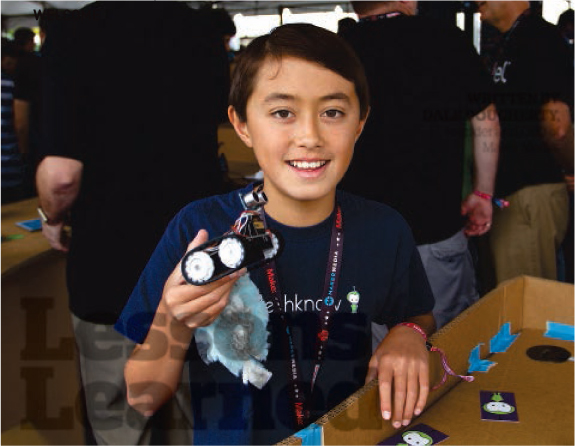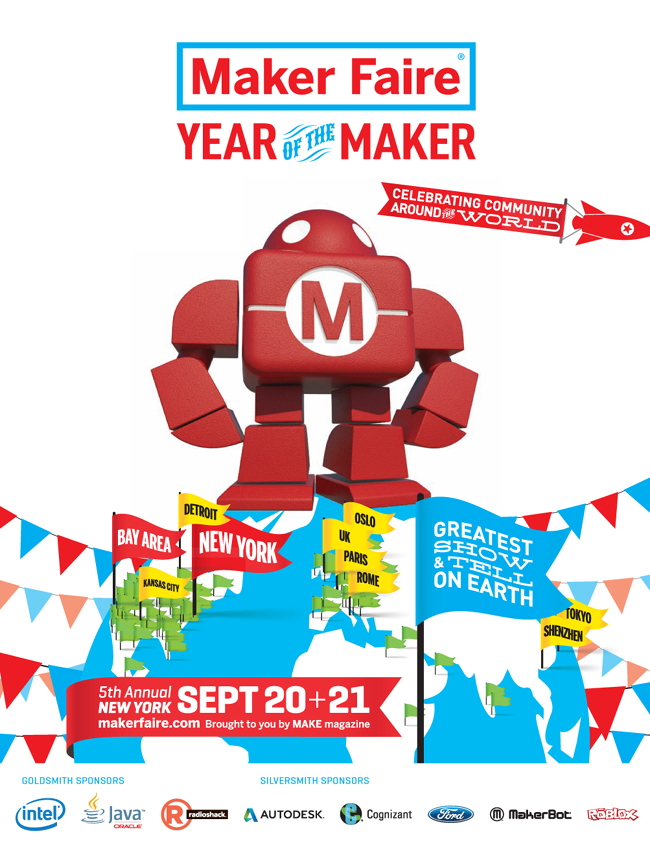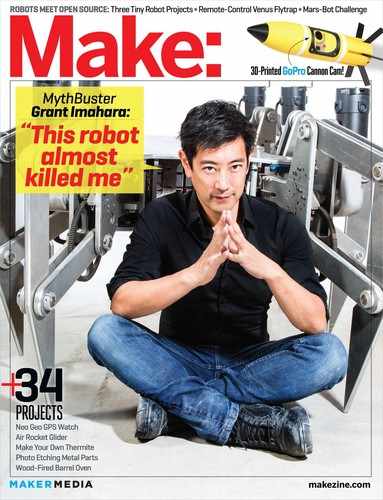WELCOME
Lessons Learned
WRITTEN BY DALE DOUGHERTY, founder and CEO of Maker Media.

Gunther Kirsch
CALL HIM THE QUINTESSENTIAL MAKER. He’s an accomplished builder who has ribbons from Maker Faire. He made his own website featuring a line of electronic kits he developed, along with tutorials. He has taught a four-hour intro class on Arduino to kids and adults at a hackerspace. He even spoke at an Atmel industry panel in New York City. Last October, he was invited to Maker Faire Rome, where he gave a talk about starting his own business. He met the mayor of Rome. Yet Quin Etnyre is just 13 years old.
Quin started reading MAKE magazine when his parents got him a subscription. Then he came to his first Maker Faire, where he learned to solder. The next year he came back to Maker Faire to exhibit his own project. Quin’s mother says that when he was 10, he was getting bored with school and needed something more challenging. Quin found a new adventure through making.
Today anyone can design and develop a product. The barriers are lower and the technology is getting easier. It means that new people can become makers — and a self-directed 13-year-old can learn to do it. Quin is special, it’s true. He has very supportive parents who give him access to the resources he needs, but he loves making.
“Going to school and running a business is hard,” Quin says. “It is a lot of work.” Quin’s website, QTechKnow.com, is where his kits are listed. One of them is a fart detector, a kit designed for an audience that Quin understands better than most. He’s learning about marketing and that his customers really like to get stickers and pins with an order. Packing kits in bags and getting them to the post office takes a lot of time, but he says, “You have to be thinking of your next project.” Quin also connects to other makers who serve as his mentors, many of whom do not live in his community.
I recently had a call from Jim Hogeboom, superintendent of the school district where Quin attends middle school. Quin had attended a school board meeting and told them what he was doing. “I made the point that I learned all of that outside of school,” Quin tells me. “Schools should be teaching things like that during the school day because it has opened up so many cool opportunities for me.” Quin is the kind of 21st-century learner that our schools aspire to produce, yet he’s trying to decide what kind of high school he should attend next year.
Quin isn’t just thinking about himself. He believes, like I do, that if schools engage more students as makers, the schools will be better and more students will discover new capabilities. Quin shared four ideas with the school board: “1) Offer more computer science courses, and higher-level courses for the geeks; 2) Put a hackerspace in every school with a great teacher who loves creativity and innovation; 3) Make this hackerspace open to all students in the school (not just the geeks) since makers can be useful in all fields of study — agriculture, music, art, psychology, etc. — and students interested in different fields can come together and collaborate on projects; and 4) Make sure we start making at the elementary and middle schools, too.”
Students like Quin are the agents of change in education. Mr. Hogeboom wanted to learn more about makerspaces in schools and how to develop the capacity for teachers to engage students as makers.
At the university level, Dr. Craig Forest is trying to provide more opportunities for students to make at the largest engineering school in the United States. Dr. Forest is an associate professor at the George W. Woodruff School of Mechanical Engineering at Georgia Tech in Atlanta, and he was named Engineering Educator of the Year in Georgia last year. He developed a student-centered makerspace called the Invention Studio (inventionstudio.gatech.edu) on campus.
The Invention Studio has become a place where any student could hang out, have access to tools, and do their own projects. The Invention Studio is open to personal projects as well as course or research projects. “From Halloween costumes to battlebots,” says Dr. Forest, “students are learning how to design and build things they are passionate about and taking ownership of their education.”
The most interesting feature of the makerspace is who runs it — the students. The Makers Club consists of 100 students who play a variety of roles in managing the space. “It’s their space,” states Dr. Forest. “And that’s key.” It’s the Makers Club’s responsibility to keep the place up and running, even welcoming newcomers and showing them how to use the equipment safely and responsibly. The Makers Club serves the needs of 1,000 users per week in the 24/7, free-to-use facility.
There are students who do well in the Invention Studio but don’t always do well in their courses. A young woman had a 2.0 GPA in her courses, but she got a great job at a large company because of the projects and leadership skills she had developed in the Invention Studio.
With the experience students gain from designing and building things, and solving real problems, I hope they can find jobs that they really enjoy. Or perhaps they will consider starting their own ventures. If so, they should connect with Quin, whose talk at Maker Faire Rome was “Lessons Learned from a 12-Year-Old CEO.” ![]()

